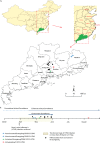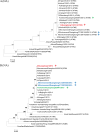Continuing reassortment leads to the genetic diversity of influenza virus H7N9 in Guangdong, China
- PMID: 24829356
- PMCID: PMC4135935
- DOI: 10.1128/JVI.00630-14
Continuing reassortment leads to the genetic diversity of influenza virus H7N9 in Guangdong, China
Abstract
On 30 March 2013, a novel avian influenza A H7N9 virus causing severe human respiratory infections was identified in China. Preliminary sequence analyses have shown that the virus is a reassortant of H7N9 and H9N2 avian influenza viruses. In this study, we conducted enhanced surveillance for H7N9 virus in Guangdong, China, from April to August 2013. We isolated two H7N9 viral strains from environmental samples associated with poultry markets and one from a clinical patient. Sequence analyses showed that the Guangdong H7N9 virus isolated from April to May shared high sequence similarity with other strains from eastern China. The A/Guangdong/1/2013 (H7N9) virus isolated from the Guangdong patient on 10 August 2013 was divergent from previously sequenced H7N9 viruses and more closely related to local circulating H9N2 viruses in the NS and NP genes. Phylogenetic analyses revealed that four internal genes of the A/Guangdong/1/2013 (H7N9) virus-the NS, NP, PB1, and PB2 genes-were in clusters different from those for H7N9 viruses identified previously in other provinces of China. The discovery presented here suggests that continuing reassortment led to the emergence of the A/Guangdong/1/2013 (H7N9) virus as a novel H7N9 virus in Guangdong, China, and that viral adaptation to avian and human hosts must be assessed.
Importance: In this study, we isolated and characterized the avian influenza A H7N9 virus in Guangdong, China, from April to August 2013. We show that the viruses isolated from Guangdong environmental samples and chickens from April to May 2013 were highly similar to other H7N9 strains found in eastern China. The H7N9 virus isolated from the clinical patient in Guangdong in August 2013 was divergent from previously identified H7N9 viruses, with the NS and NP genes originating from recent H9N2 viruses circulating in the province. This study provides direct evidence that continuing reassortment occurred and led to the emergence of a novel H7N9 influenza virus in Guangdong, China. These results also shed light on how the H7N9 virus evolved, which is critically important for future monitoring and tracing of viral transmission.
Copyright © 2014, American Society for Microbiology. All Rights Reserved.
Figures







Similar articles
-
Influenza H7N9 and H9N2 viruses: coexistence in poultry linked to human H7N9 infection and genome characteristics.J Virol. 2014 Mar;88(6):3423-31. doi: 10.1128/JVI.02059-13. Epub 2014 Jan 8. J Virol. 2014. PMID: 24403589 Free PMC article.
-
Unique reassortant of influenza A(H7N9) virus associated with severe disease emerging in Hong Kong.J Infect. 2014 Jul;69(1):60-8. doi: 10.1016/j.jinf.2014.02.012. Epub 2014 Feb 24. J Infect. 2014. PMID: 24576826 Free PMC article.
-
Coinfection of Chickens with H9N2 and H7N9 Avian Influenza Viruses Leads to Emergence of Reassortant H9N9 Virus with Increased Fitness for Poultry and a Zoonotic Potential.J Virol. 2022 Mar 9;96(5):e0185621. doi: 10.1128/jvi.01856-21. Epub 2022 Jan 12. J Virol. 2022. PMID: 35019727 Free PMC article.
-
Emergence and development of H7N9 influenza viruses in China.Curr Opin Virol. 2016 Feb;16:106-113. doi: 10.1016/j.coviro.2016.01.020. Epub 2016 Feb 26. Curr Opin Virol. 2016. PMID: 26922715 Review.
-
Novel human H7N9 influenza virus in China.Integr Zool. 2014 Jun;9(3):372-5. doi: 10.1111/1749-4877.12047. Integr Zool. 2014. PMID: 24952971 Review.
Cited by
-
Dissemination, divergence and establishment of H7N9 influenza viruses in China.Nature. 2015 Jun 4;522(7554):102-5. doi: 10.1038/nature14348. Epub 2015 Mar 11. Nature. 2015. PMID: 25762140
-
Quantitative risk analysis of the novel H7N9 virus in environments associated with H9 avian influenza virus, Zhejiang province, China.Epidemiol Infect. 2017 Jan;145(1):133-140. doi: 10.1017/S0950268816002168. Epub 2016 Sep 28. Epidemiol Infect. 2017. PMID: 27678396 Free PMC article.
-
Sustained live poultry market surveillance contributes to early warnings for human infection with avian influenza viruses.Emerg Microbes Infect. 2016 Aug 3;5(8):e79. doi: 10.1038/emi.2016.75. Emerg Microbes Infect. 2016. PMID: 27485495 Free PMC article.
-
Report on the second WHO integrated meeting on development and clinical trials of influenza vaccines that induce broadly protective and long-lasting immune responses: Geneva, Switzerland, 5-7 May 2014.Vaccine. 2015 Nov 27;33(48):6503-10. doi: 10.1016/j.vaccine.2015.10.014. Epub 2015 Oct 23. Vaccine. 2015. PMID: 26478203 Free PMC article.
-
Molecular Evolution, Diversity, and Adaptation of Influenza A(H7N9) Viruses in China.Emerg Infect Dis. 2018 Oct;24(10):1795-1805. doi: 10.3201/eid2410.171063. Emerg Infect Dis. 2018. PMID: 30226157 Free PMC article.
References
-
- Chen Y, Liang W, Yang S, Wu N, Gao H, Sheng J, Yao H, Wo J, Fang Q, Cui D, Li Y, Yao X, Zhang Y, Wu H, Zheng S, Diao H, Xia S, Chan KH, Tsoi HW, Teng JL, Song W, Wang P, Lau SY, Zheng M, Chan JF, To KK, Chen H, Li L, Yuen KY. 2013. Human infections with the emerging avian influenza A H7N9 virus from wet market poultry: clinical analysis and characterisation of viral genome. Lancet 381:1916–1925. 10.1016/S0140-6736(13)60903-4 - DOI - PMC - PubMed
-
- Gao R, Cao B, Hu Y, Feng Z, Wang D, Hu W, Chen J, Jie Z, Qiu H, Xu K, Xu X, Lu H, Zhu W, Gao Z, Xiang N, Shen Y, He Z, Gu Y, Zhang Z, Yang Y, Zhao X, Zhou L, Li X, Zou S, Zhang Y, Yang L, Guo J, Dong J, Li Q, Dong L, Zhu Y, Bai T, Wang S, Hao P, Yang W, Han J, Yu H, Li D, Gao GF, Wu G, Wang Y, Yuan Z, Shu Y. 2013. Human infection with a novel avian-origin influenza A (H7N9) virus. N. Engl. J. Med. 368:1888–1897. 10.1056/NEJMoa1304459 - DOI - PubMed
-
- Liu W, Yang K, Qi X, Xu K, Ji H, Ai J, Ge A, Wu Y, Li Y, Dai Q, Liang Q, Bao C, Bergquist R, Tang F, Zhu Y. 2013. Spatial and temporal analysis of human infection with avian influenza A(H7N9) virus in China, 2013. Euro Surveill. 18(47):pii=20640 http://www.eurosurveillance.org/ViewArticle.aspx?ArticleId=20640 - PubMed
-
- Lam TT, Wang J, Shen Y, Zhou B, Duan L, Cheung CL, Ma C, Lycett SJ, Leung CY, Chen X, Li L, Hong W, Chai Y, Zhou L, Liang H, Ou Z, Liu Y, Farooqui A, Kelvin DJ, Poon LL, Smith DK, Pybus OG, Leung GM, Shu Y, Webster RG, Webby RJ, Peiris JS, Rambaut A, Zhu H, Guan Y. 2013. The genesis and source of the H7N9 influenza viruses causing human infections in China. Nature 502:241–244. 10.1038/nature12515 - DOI - PMC - PubMed
Publication types
MeSH terms
Substances
LinkOut - more resources
Full Text Sources
Other Literature Sources
Medical
Miscellaneous

